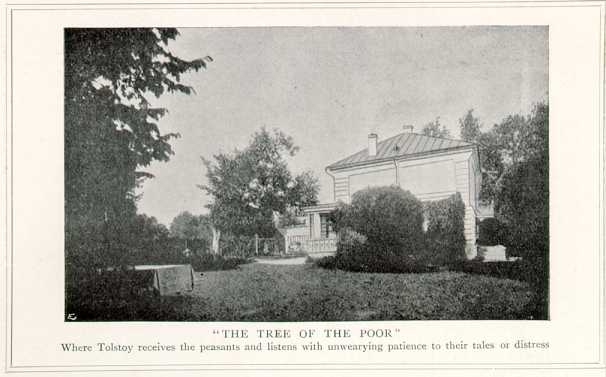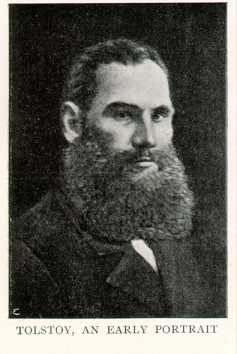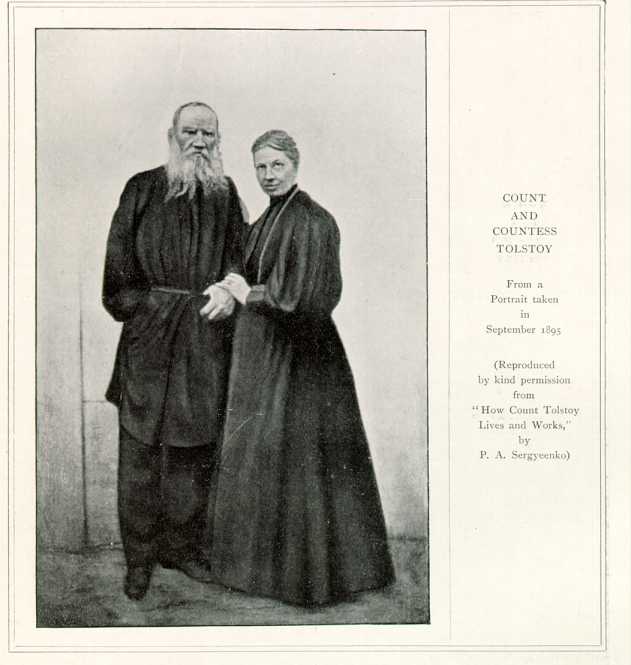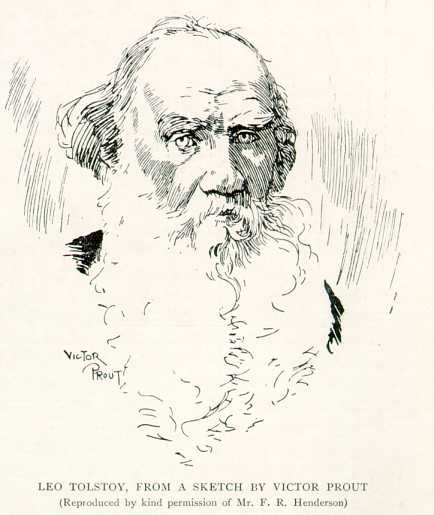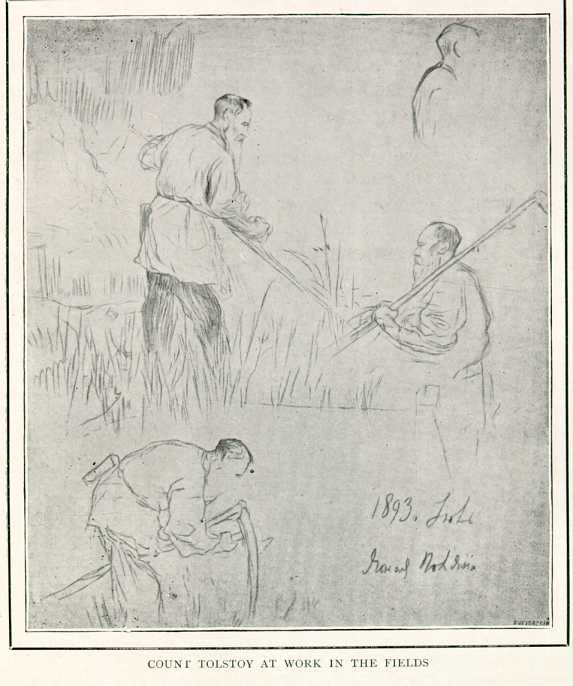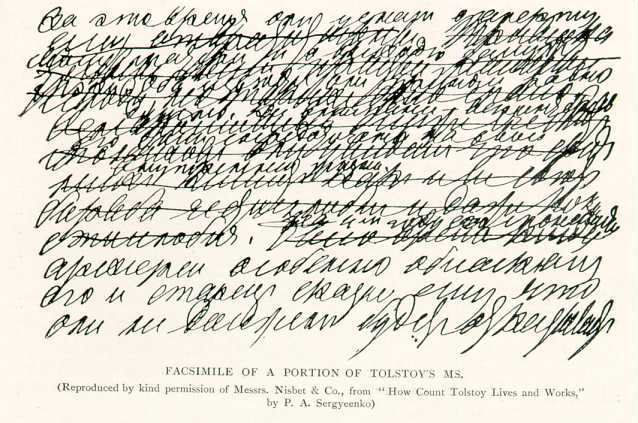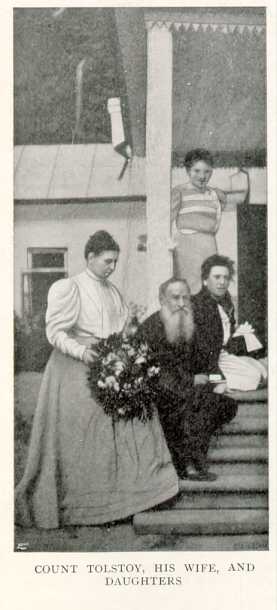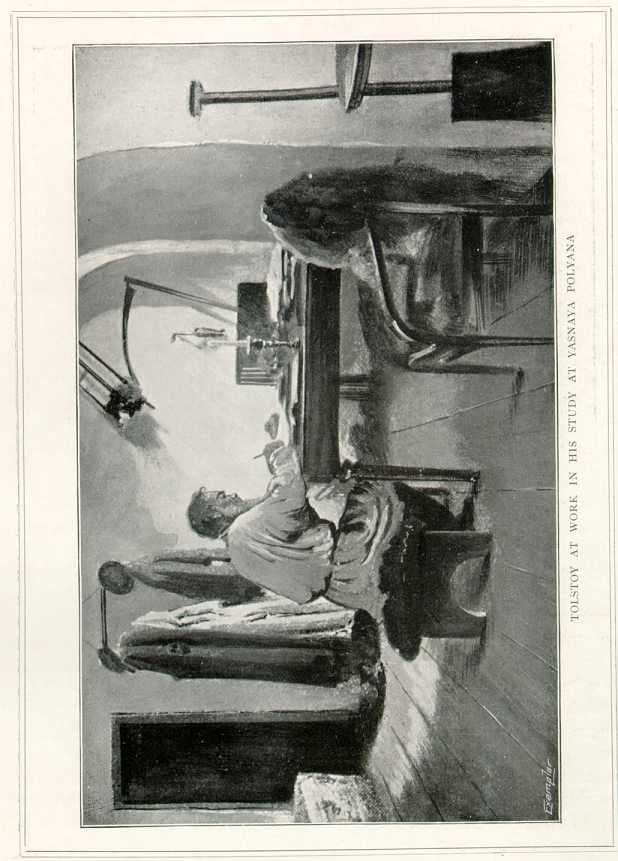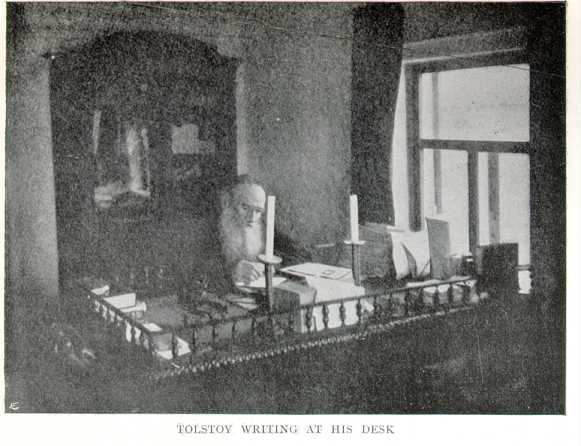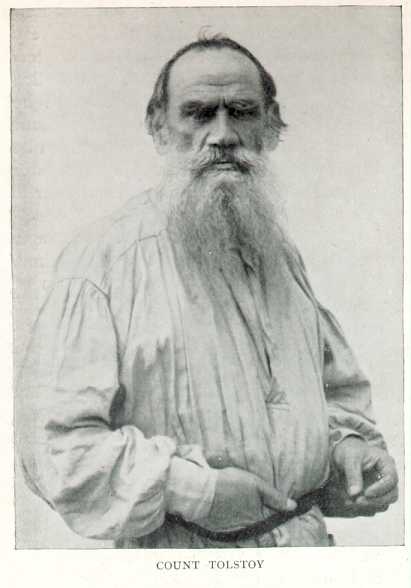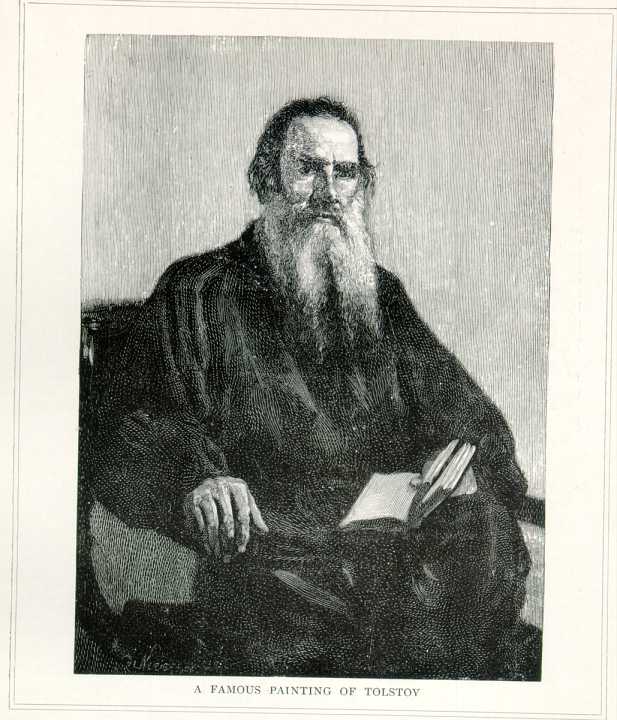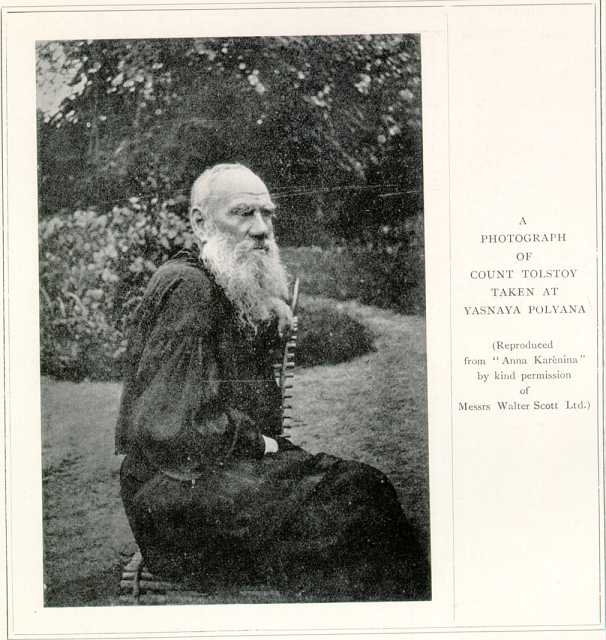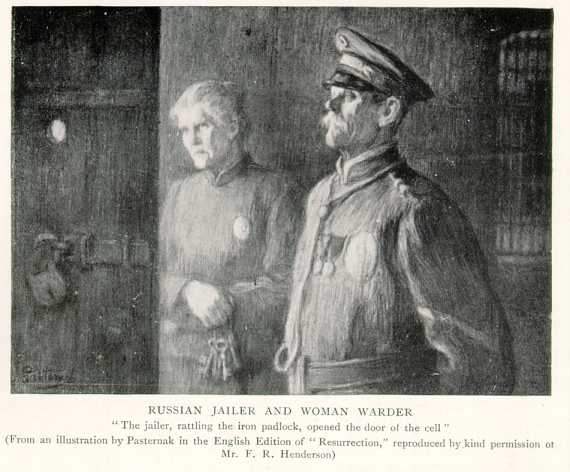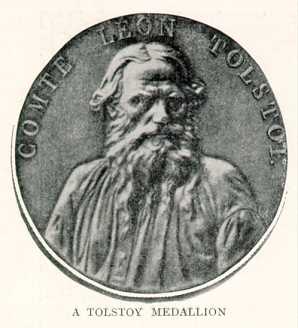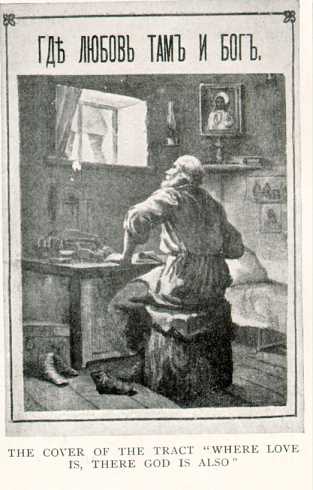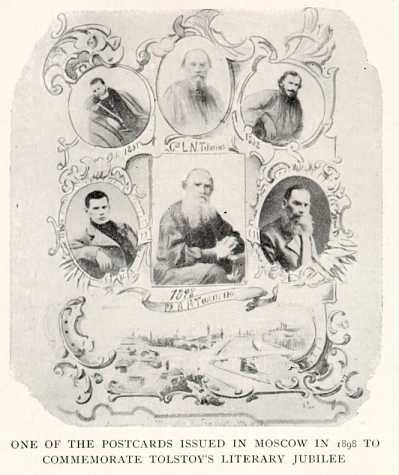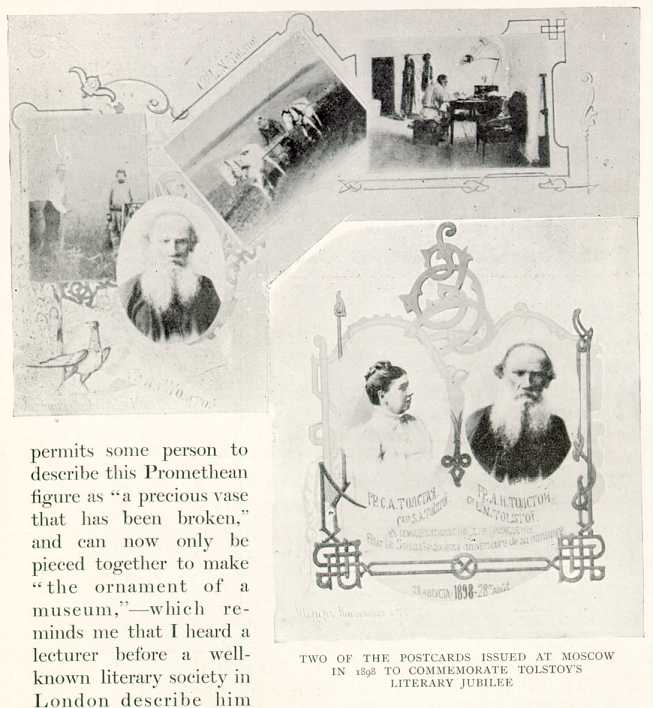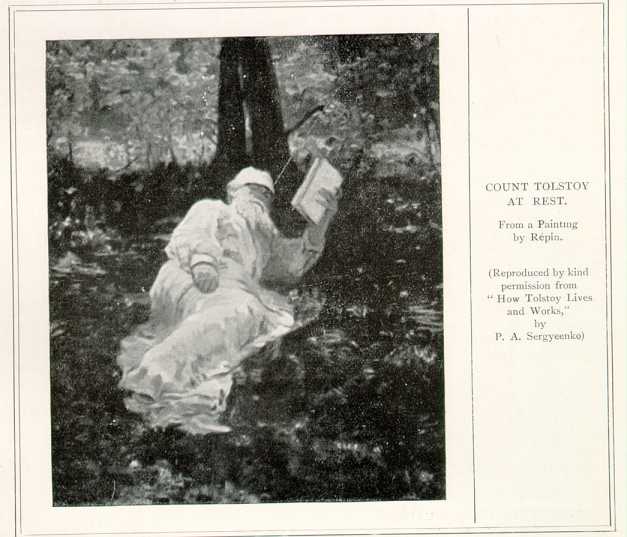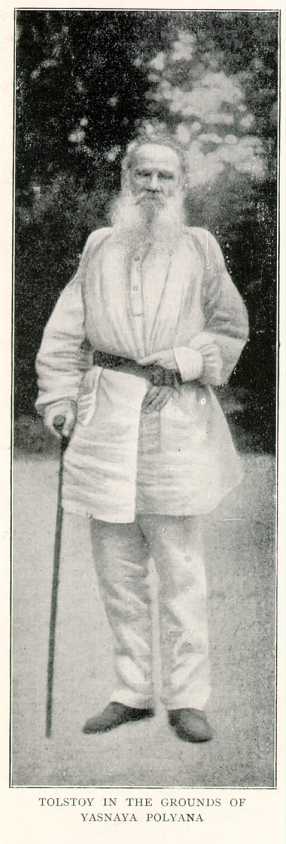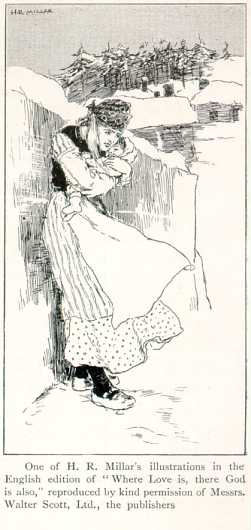2. LEO TOLSTOY AS WRITER
HALF the ignorance or misunderstanding of this greatest
living figure in literature comes of the attempt to judge
him as we judge the specialised Western novelist — an
utterly futile method of approach. He is a Russian, in the
first place. Had he come to Paris with Turguenieff, he
might have been similarly re-nationalised, might possibly
have developed into a writer pure and simple; the world
might so have gained a few great romances-it would
have lost infinitely in other directions. Turguenieff wished
it so. " My friend," he wrote to Tolstoy from his deathbed,
" return to literature ! Reflect that that gift comes to you
whence everything comes to us. Ah! how happy I should
be if I could think that my prayers could influence you....
My friend, great writer of our Russian land, hear my
entreaty!" For
once, the second greatest of modern
Russians took a narrow view of character and destiny.
Genius must work itself out on its own lines. Tolstoy
remained a Russian from tip to toe-that is one of his
supreme values for us; and he remained an indivisible
personality. The artist and the moralist are inseparable in
his works. "We are not to take ' Anna Karenina ' as a work
of art," said Matthew
Arnold; "we are to take it as a piece
of life." The distinction is not very satisfactorily stated,
but the meaning is clear. So, too, W. D. Howells, in his
introduction to an American edition of the "Sebastopol
Sketches": "I do not know how it is with others to whom
these books of Tolstoy's have come, but for my part I
cannot think of them as literature in the artistic sense at
all. Some people complain to me when I praise them that
they are too long, too diffuse, too confused, that the
characters' names are hard to pronounce, and that the life
they portray is very sad and not amusing. In the presence
of these criticisms I can only say that I find them nothing
of the kind, but that each history of Tolstoy's is as clear,
as orderly, as brief, as something I have lived through
myself. I cannot think of any service which imaginative literature
has done the race so great as that which Tolstoy has done
in his conception of Karenina at that crucial moment
when the cruelly outraged man sees that he cannot be
good with dignity. This leaves all tricks of fancy, all
effects of art, immeasurably behind." So much being said,
however, we may be allowed to emphasise in this qualities
and achievements of Tolstoy as artist, rather than the
expositions of Christian Anarchism and the social
philippics
under which those achievements have been
somewhat hidden in recent years.
Morbid introspectiveness and the spirit of revolt
inevitably colour what is best in nineteenth-century
Russia. Born at Yasnaya Polyana ("Clear Field"), Tula, in
1828, and early orphaned, Tolstoy's youth
synchronised
with the period of reaction that brought the Empire to the
humiliating disasters of the Crimean War. No hope was
left in the thin layer of society lying between the two
mill-stones of the Court and the serfs; none in the little
sphere of art where Byronic romanticism was ready to
expire. The boy saw from the first the rottenness of the
patriarchal aristocracy in which his lot seemed to be cast.
Precocious, abnormally sensitive and observant, impatient
of discipline and formal learning, awkward and bashful,
always brooding, not a little conceited, he was a sceptic at
fifteen, and left the University of Kazan in disgust at the
stupid conventions of the time and place, without taking
his degree. " Childhood, Boyhood, and Youth"-which
appeared in three sections between 1852 and 1857-tells
the story of this period, though the figure of Irtenieff is
probably a projection rather than a portrait of himself, to
whom he is always less fair, not to say merciful, than to
others. This book is a most uncompromising exercise in
self-analysis. It of great length, there is no plot, and few
outer events are recorded.
The realism is generally morbid, but is varied by some
passages of great descriptive power, such as the account
of the storm, and occasionally with tender pathos, as in
the story of the soldier's death, as well as by grimly vivid
pages, such as the narrative of the mother's death. In this
earliest work will be found the seeds both of Tolstoy's
artistic genius and of his ethical gospel.
After five years of mildly benevolent efforts among his
serfs at Yasnaya Polyana (the disappointments of which
he related a few years later in "A Landlord's Morning,"
intended to have been part of a full novel called "A
Russian Proprietor"), his elder brother Nicholas persuaded
him to join the army, and in 1851 he was drafted to the
Caucasus as an artillery officer. On this favourite stage of
Russian romance, where for the first time he saw the
towering mountains and the tropical sun, and met the
rugged adventurous highlanders, Tolstoy felt his
imagination stirred as Byron among the isles of Greece,
and his early revulsion against city life confirmed as
Wordsworth amid the Lakes, as Thoreau at Walden, by a
direct call from Nature to his own heart. The largest result
of this experience was "The Cossacks" (1852).
Turguenieff described this fine prose epic of the contact
of civilised and savage man as "the best novel written in
our language." " The Raid " (or "The Invaders," as Mr.
Dole's translation is entitled), same year, "The Wood-Cutting Expedition " (1855), "Meeting an Old Acquaintance"
(1856), and "A
Prisoner in the Caucasus" (1862) are also
drawn from recollections of this sojourn, and show the
same descriptive and romantic power. Upon the outbreak
of the Crimean War the Count was called to Sebastopol,
where he had command of a battery, and took part in the
defence of the citadel. The immediate product of these
dark months of bloodshed was the thrilling series of
impressions reprinted from one of the leading Russian
reviews as "Sebastopol Sketches" (1856). From that day
onward Tolstoy knew and hateful truth about war and the
thoughtless pseudo-patriotism which hurries nations into
fratricidal slaughter. From that there was expunged from
his mind all the cheap romanticism which depends upon
the glorification of the savage nature. These wonderful
pictures of the routine of the battlefield established his
position in Russia as a writer, and later on created in
Western countries an impression like that of the canvases
of Verestchagin.
For a brief time Tolstoy became a figure in the old and
new capitals of Russia by right of talent as well as birth.
His very chequered friendship with Turguenieff, one of
the oddest chapters in literary history, can only be
mentioned here. In 1857 he travelled in Germany, France,
and Italy. lt was of these years that he declared in "My
Confession" that he could not think of them without
horror, disgust, and pain of heart. The catalogue of crime
which he charged against himself in his salvationist crisis
of twenty years later must not be taken literally; but that
there was some ground for it we may guess from the
scenic and incidental realism of the " Recollections of a
Billiard Marker" (1856), and of many a later page. Several
other powerful short novels date from about this time,
including " Albert " and " Lucerne," both of which remind
us of the Count's susceptibility to music; " Polikushka," a
tale of peasant life; and "Family Happiness," the story of a
marriage that failed, a most clear, consistent, forceful, and
in parts beautiful piece of work, anticipating in essentials
" The Kreutzer Sonata" that was to scandalise the world
thirty years afterward.
After all, it was family happiness that saved Leo Tolstoy.
For the third time the hand of death had snatched away
one of the nearest to him-his brother Nicholas. Two
years later, in 1862, he married Miss Behrs, daughter of
the army surgeon in Tula-the most fortunate thing that
has happened to him in his whole life, I should think.
Family responsibilities, those novel and daring
experiments in peasant education which are recorded in
several volumes of the highest interest, the supervision of
the estate, magisterial
work, and last, but not least, the
prolonged labours upon " War and Peace " and " Anna
Karenina " fill up the next fifteen years. " War and Peace" (1864-9) is a huge panorama of the Napoleonic
campaign of 1812, with preceding and succeeding
episodes in Russian society. These four volumes display
in their superlative degree Tolstoy's indifference to plot
and his absorption in individual character; they are rather
a series of scenes threaded upon the fortunes of several
families than a set novel; but they contain passages of
penetrating psychology and vivid description, as well as a
certain amount of anarchist theorising. Of this work, by
which its author became known in the West, Flaubert
(how the name carries us backward !) wrote: " It is of the
first order. What a painter and what a psychologist ! The
two first volumes are sublime, but the third drags
frightfully. There are some quite Shakespearean things in
it." The artist's hand was now strengthening for his
highest attainment. In 1876 appeared "Anna Karenina,"
his greatest, and as he intended at the time (but Art is not
so easily jilted), his last novel. The fine qualities of this
book, which, though long, is
dramatically unified and
vitally coherent, have been so fully recognised that I need
not attempt to describe them. Mr. George Meredith has
described Anna as " the most perfectly depicted female
character in all fiction," which, from the author of "Diana,"
is praise indeed. Parallel with the main subject of
the illicit love of Anna and Vronsky there is a minor
subject in the fortunes of Levin and Kitty, wherein the
reader will discover many of Tolstoy's own experiences.
Matthew Arnold complained that the book contained too
many characters and a burdensome multiplicity of
actions, but praised its author's extraordinarily fine
perception and no less extraordinary truthfulness, and
frankly revelled in Anna's
"large, fresh, rich, generous,
delightful nature." " When I had ended my work 'Anna
Karenina,' " said Tolstoy in " My Confession" (1879-82),
" my despair reached such a height that I could do nothing
but think of the horrible condition in which I found
myself.... I saw only one thing-Death. Everything else
was a lie." Of that spiritual crisis nothing need be said
here except that it only intensified, and did not really, as it
seemed to do, vitally change, principles and instincts
which had possessed Tolstoy from the beginning. His
subsequent ethical and religious development may be
traced in a long series of books and pamphlets, of which
the most important are "The Gospels Translated,
Compared, and Harmonised " (1880-2), " What I Believe" ["My Religion"], produced abroad in 1884, " What is
to be Done ? " (1884-5), " Life " (1887), " Work " (1888),
" The Kingdom of God is Within You " (1893),
"Non-Action" (1894), "Patriotism and Christianity"
(1896)—
crusade, in the foreign and the clandestine presses
at least, against all Imperial authority and social
maladjustments. Mr. Tchertkoff, Mr. Aylmer Maudej the
" Brotherhood Publishing Co.," and the "Free Age Press"
deserve praise for their efforts to popularise these and
other works of the Count in thoroughly good translations.
In "What is Art?" (1898), not content with the bare
utilitarian argument that it is merely a means of social
union, he launched a
jehad against all modern ideas of Art
which rely upon a conception of beauty and all ideas of
beauty into which pleasure enters as a leading constituent.
A short but luminous essay on " Guy de Maupassant and
the Art of Fiction" is a scathing attack upon militarism in
general and the Franco-Russian Alliance in
particular-"The Christian Teaching " (1898), and " The
Slavery of our Times " (1900). Various letters on the
successive famines and on the religious persecutions in
Russia deserve separate mention; they remind us that
since the failure of the revolutionary movement miscalled
" Nihilism'' Tolstoy has gradually risen to the position of
the one man who can continue with impunity a public
more satisfactory contribution to the subject.
It is more to our purpose to note that in this volcanic and
fecund if fundamentally simple personality the artist has
dogged the steps of the evangelist to the last. " Master and
Man" (1895) is one of the most exquisite short stories
ever written. " The Death of Ivan Ilyitch" (1884) and "
Resurrection " (1599' are in some ways the most powerful
of all his works. The much condemned "Dominion of
Darkness" (1886) and " Kreutzer Sonata" (1889) will be
more fairly judged when the average Englishman has
learned the supreme merit of that uncompromising
truthfulness which gives nobility to every line the grand
Russian ever wrote. To submit a work like " Resurrection"
to the summary treatment which the ordinary novel
receives and merits is absurd. It is a large picture of the
fall and rise of man done by the swift and restless hand of
a master who stands in a category apart, with an eye that
sees externals and essentials with like accuracy and
rapidity. Because the dramatic quality of these living
pictures lies, not in their organisation into a
conventionally limited plot, but first in the challenging
idea upon which they are founded, then the inexorable
development of individual characters, and ever and anon
in the grip of particular episodes, the little critics scoff.
The idea, the characters, the episodes are all too real and
precious British self-complacency. The grandmotherly
Athenœum
permits some person to describe this
Promethean figure as "a precious vase that has been
broken," and can now only be pieced together to make "
the ornament of a museum,"—which reminds me that I
heard a lecturer before a well-known literary society in
London describe him lately as a "scavenger," and that a
city bookseller assured me the other day that there was
something almost amounting to a boycott against his
fiction in the shops. The publisher who is preparing a
complete edition of Tolstoy—enormous work!—knows
better, knows that Tolstoy is one of the world-spirits
whose advance out of the
obscurity of a benighted land
into the largest contemporary circulation is but a foretaste
of an influence that will soon be co-extensive with the
commonwealth of thinking men and women.
His service to literature is precisely the same as his
service to morals. Like Bunyan and Burns, Dickens and
Whitman, he throws down in a world of decadent
conventions the gauge of the democratic ideal. As he calls
the politician and the social reformer back to the land and
the common people, so he calls the artist back to the
elemental forces ever at work beneath the surface-show of
nature and humanity. With an extraordinary penetration
into the hidden recesses of character, he joins a terrible
truthfulness, and that absolute
simplicity of manner which
we generally associate with genius. He is a realist, not
merely of the outer, but more especially of the inner life.
There is no staginess, no sentimentality, in his work. He
has no heroes in our Western sense, none, even, of those
sensational types of personality which glorify the name of
his Northern contemporary, Ibsen. His style is always
natural, direct, irresistible as a physical process. He has
rarely strayed beyond the channel of his own experience,
and the reader who prefers breadth to depth of knowledge
must seek elsewhere. He has little humour, but a grimly
satiric note has sometimes crept into his writing, as
Archdeacon Farrar will remember. Of artifice designed for
vulgar entertainment he knows nothing; in the world of
true art, which is the wine-press of the soul of man, he
stands, a princely figure. Theories, prescriptions, and
discussions are forgotten, and we think only with love and
reverence of this modern patriarch, so lonely amid the
daily enlarging congregation of the hearts he has
awakened to a sense of the mystery, the terror, the joy, the
splendour of human destinies.
G. H. PERRIS.
